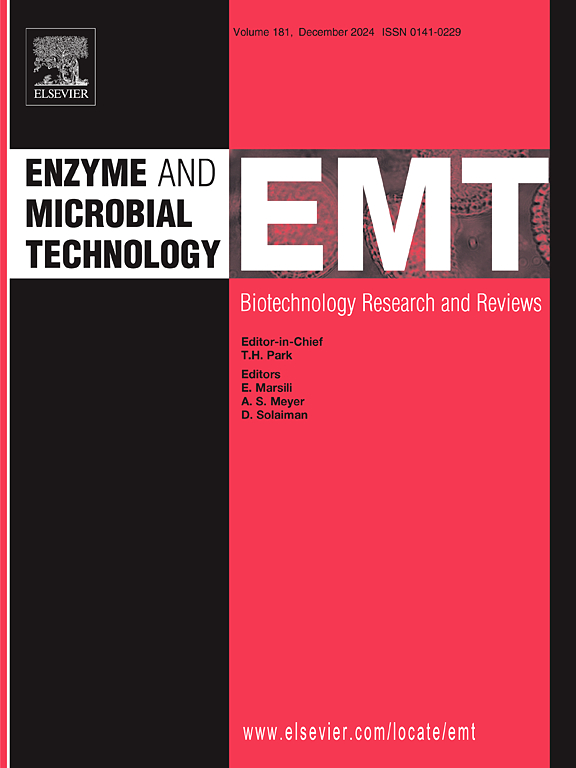Advances in engineering and applications of microbial glutamate decarboxylases for gamma-aminobutyric acid production
IF 3.7
3区 生物学
Q2 BIOTECHNOLOGY & APPLIED MICROBIOLOGY
引用次数: 0
Abstract
Gamma-aminobutyric acid (GABA) is a key neurotransmitter with significant health benefits, including anxiolytic and anti-hypertensive effects, and potential use in biodegradable material synthesis. The increasing market demand for GABA has intensified the search for cost-effective production methods. The key enzyme involved in GABA production is glutamate decarboxylase (GAD), which catalyzes the conversion of L-glutamate to GABA. GAD plays a central role in various production approaches, such as enzyme-based catalysis, whole-cell catalysis, and microbial fermentation. Although microbial GADs are preferred for their high catalytic activity, their low pH and thermal stability present significant challenges for large-scale GABA production. Wild-type GADs typically have an optimal pH range of 4–5, and their activity sharply declines as the pH increases, thereby reducing production efficiency. Furthermore, GADs' poor thermal stability makes them vulnerable to temperature fluctuations during industrial processes, further limiting GABA production. Recent research has focused on engineering GAD variants with improved stability and performance through rational design, directed evolution, and semi rational approaches. These advancements not only expand the potential applications of GAD in biocatalysis but also offer promising solutions for sustainable GABA production. This paper provides an in-depth review of the engineering of GADs, applications of GAD in GABA production, and strategies to overcome limitations, offering a comprehensive overview of the current state and future prospects of GAD modification in enhancing GABA production.
微生物谷氨酸脱羧酶在γ -氨基丁酸生产中的工程与应用进展
γ -氨基丁酸(GABA)是一种重要的神经递质,具有显著的健康益处,包括抗焦虑和抗高血压作用,并可能用于生物可降解材料的合成。对氨基丁酸的市场需求日益增加,促使人们加紧寻找具有成本效益的生产方法。GABA产生的关键酶是谷氨酸脱羧酶(GAD),它催化l -谷氨酸转化为GABA。GAD在各种生产方法中起着核心作用,如酶催化、全细胞催化和微生物发酵。尽管微生物GADs因其高催化活性而受到青睐,但其低pH值和热稳定性对大规模生产GABA提出了重大挑战。野生型GADs的最适pH值为4 ~ 5,其活性随着pH值的升高而急剧下降,从而降低了生产效率。此外,GADs较差的热稳定性使其在工业过程中容易受到温度波动的影响,进一步限制了GABA的生产。最近的研究集中在通过合理设计、定向进化和半合理方法提高稳定性和性能的工程GAD变体上。这些进展不仅扩大了GAD在生物催化中的潜在应用,而且为可持续生产GABA提供了有希望的解决方案。本文对GAD的工程、GAD在GABA生产中的应用以及克服限制的策略进行了深入的综述,并对GAD改性提高GABA生产的现状和未来前景进行了全面的概述。
本文章由计算机程序翻译,如有差异,请以英文原文为准。
求助全文
约1分钟内获得全文
求助全文
来源期刊

Enzyme and Microbial Technology
生物-生物工程与应用微生物
CiteScore
7.60
自引率
5.90%
发文量
142
审稿时长
38 days
期刊介绍:
Enzyme and Microbial Technology is an international, peer-reviewed journal publishing original research and reviews, of biotechnological significance and novelty, on basic and applied aspects of the science and technology of processes involving the use of enzymes, micro-organisms, animal cells and plant cells.
We especially encourage submissions on:
Biocatalysis and the use of Directed Evolution in Synthetic Biology and Biotechnology
Biotechnological Production of New Bioactive Molecules, Biomaterials, Biopharmaceuticals, and Biofuels
New Imaging Techniques and Biosensors, especially as applicable to Healthcare and Systems Biology
New Biotechnological Approaches in Genomics, Proteomics and Metabolomics
Metabolic Engineering, Biomolecular Engineering and Nanobiotechnology
Manuscripts which report isolation, purification, immobilization or utilization of organisms or enzymes which are already well-described in the literature are not suitable for publication in EMT, unless their primary purpose is to report significant new findings or approaches which are of broad biotechnological importance. Similarly, manuscripts which report optimization studies on well-established processes are inappropriate. EMT does not accept papers dealing with mathematical modeling unless they report significant, new experimental data.
 求助内容:
求助内容: 应助结果提醒方式:
应助结果提醒方式:


